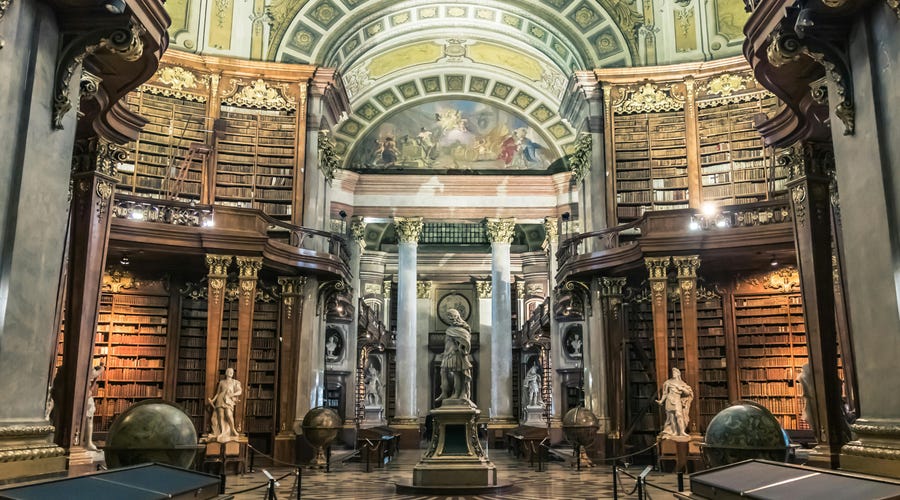Austria is the home of classical music, big thinkers like Siegmund Freud, Sacher cake and the Waltz - all set against the stunning backdrop of the Alps.
This beautiful country is not only celebrated for its breathtaking landscapes but also as a nation of musical and intellectual heritage, characterized by an appreciation for the arts, a strong sense of history, and a commitment to environmental preservation.
Maybe you’re learning standard German but it’s getting a little too easy for you? Or you’ve understandably fallen in love with Austria and just want to know more about the Austrian German language?
If you’re learning German through an Austrian lens, understanding the country's historical and cultural backdrop will help you tremendously. So put on your dancing shoes for a waltz through Austrian culture and traditions, starting with a breakdown of its rich history.
Table of contents
- Historical context about Austrian culture
- Austrian language and communication
- Arts and literature
- Austrian dance and music
- Austrian cuisine
- Austrian customs and traditions
- Austrian society
- Conclusion
Historical context about Austrian culture
Austrian history begins with its early days as part of the Holy Roman Empire around 15 BC when the majority of what we now know as Austria was annexed. This marks the beginning of 500 years of the so-called "Austria Romana".
From 1804 to 1867, Austria saw its most powerful phase under the Habsburg monarchy, and extended its influence across Europe. Vienna became a cultural center during this time, celebrated for its contributions to music, art, and philosophy.
After World War I, the Austro-Hungarian Empire dissolved, leaving Austria as a smaller, independent republic. This transition was challenging and marked by economic and political instability. During World War II, Austria was annexed by Germany, a period that ended in 1945.
Post-war, Austria regained its independence with the 1955 State Treaty and adopted a stance of permanent neutrality. Since then, it has developed into a stable nation, joining the European Union in 1995. Today, Austria’s past influences are visible in a mixture of commitment to peace and cultural pride.

Austrian language and communication
Austrian language
Austrian German is one of the major variants of the German language and is primarily spoken in Austria. Here are some fun facts about Austrian German:
- Official language: Austrian German is the official language of Austria and differs in vocabulary, pronunciation, and some grammar specifics from German as spoken in Germany
- Native Speakers: Approximately 8.9 million people speak Austrian German as their first language
- Second Language Speakers: Many in Austria and the surrounding regions learn Austrian German as a second language, often through cultural immersion
- Unique Characters: Just like German, Austrian German uses the characters ä, ö, ü, and ß, also known as “Umlaute”
- Pronunciation: Pronunciation can be challenging for non-native speakers, particularly the distinct sounds like "ch," soft "g," and the rolled "r"
- Vocabulary: Austrian German includes unique terms such as "Jänner" (January), "Sackerl" (bag), "Topfen" (quark), and "Fisolen" (green beans), which are different from standard German and can be difficult to understand for other German-speakers
Austrian dialects and regional variations
Austria has a variety of German dialects and regional linguistic variations:
- Standard Austrian German (Hochdeutsch): Used in formal contexts and taught in schools across Austria as the standard form
- Viennese German (Wienerisch): Spoken in Vienna, this dialect is especially known for its melodic intonation
- Bavarian Austrian (Bairisch-Österreichisch): Spoken around the border to Bavaria, this is similar to the Bavarian dialect in Germany
- Alemannic German (Alemannisch): Found in the westernmost state of Vorarlberg and parts of Tyrol, this dialect group is more similar to the dialects of Switzerland and Swabia than to other Austrian German dialects
- Styrian (Steirisch): Spoken in Styria, it features a mix of Central and Southern Bavarian characteristics
- Carinthian (Kärntnerisch): Predominant in Carinthia, this dialect has Slavic influences due to the historical presence of Slovenian populations
Importance of politeness and formality
Just like Germans, Austrians value politeness but they’re often not quite as formal. You’ll notice that Austrians generally change to the informal “du” a lot quicker than Germans. They also tend to communicate in a less direct way.
While a lot of Germans like to get to the point right away, Austrians sometimes prefer saying things “durch die Blume” (literally: through the flower) - meaning in a nice and subtle way.
Communication styles in business and social settings
You’ll notice specific communication patterns in Austrian culture, especially in professional settings. Understanding and adapting to those can be a challenge if you’re used to American work culture and business etiquette - but we’ve got you.Here are five things to keep in mind if you find yourself in an Austrian business setting:
- Preparation: Come to meetings well-prepared and with a clear agenda. The detail-oriented Austrians will appreciate it!
- Body language: Read people’s body language to make sure you’re in line and they’re comfortable around you. Pay attention to things like personal space and eye contact.
- “Du” vs. “Sie”: Using titles and last names when addressing strangers in the workplace is a safe option but it’s always best to mirror what form the other person is using.
- Work attire: Similar to Germans, Austrians dress pretty casual but still neat, clean and not too individualistic. So no need to wear traditional Austrian clothing or special work attire but you should be prepared to dress more on the conservative side.
Arts and literature
Overview of Austrian literature
Austrian literature may not be world-famous but that just means there’s even more for you to still discover! Here are some unique narrative voices you probably haven’t heard of - from Zweig to Handke:

- "Die Schachnovelle" (Chess Story) by Stefan Zweig
- “Die Klavierspielerin” (The Piano Teacher) by Elfriede Jelinek
- "Der Mann ohne Eigenschaften" (The Man Without Qualities) by Robert Musil
- "Malina" (Malina) by Ingeborg Bachmann
- "Die Angst des Tormanns beim Elfmeter” (The Goalie's Anxiety at the Penalty Kick) by Peter Handke
Influence of Austrian philosophers
Austrian intellectuals had a profound impact on different domains of knowledge, from philosophy to science, and modern social theories. Let’s start with the famous founder of psychoanalysis:
- Sigmund Freud's development of psychoanalysis revolutionized the understanding of human psychology, and introduced fundamental concepts about the unconscious mind.
- Ludwig Wittgenstein contributed especially in the fields of linguistic philosophy and logical positivism with topics of language, logic, and the limits of thought.
- Karl Popper's philosophy of science reshaped modern scientific investigation and epistemology.
Contemporary Austrian literature and art scene
Contemporary Austrian literature and art also explore deep existential questions that reflect the history of the Austrian people. There is a sharp satirical edge to many Austrian art forms, as artists use their work to engage with social and political issues, often in the context of Austria's historical and cultural significance.
Austrian dance and music
Classical heritage of Austrian music
Austria's dance and music scene is mostly known for its classical heritage with legendary composers like Wolfgang Amadeus Mozart and Franz Schubert.
- Mozart composed over 600 works, including symphonies, operas, and chamber music.
- Schubert was born in Vienna, the city that is often referred to as the "City of Music," and still known as the center for classical composition and performance.
- Even Beethoven, although German by birth, spent much of his career in Vienna.
- Another famous composer was Johann Strauss II, also known as the “Waltz king”!
Traditional Austrian dances
Speaking of the Waltz, we’ll have to mention Austria’s many different dance styles, of course. Here's a closer look at some of the more widely known Austrian traditional dances:
- Walzer: The waltz is the most famous Austrian dance, particularly the Viennese Waltz, which is faster than the traditional version and known for its elegant and flowing movements that you can witness especially during the ball season in Vienna
- Ländler: Often seen as a precursor to the waltz, the Ländler is a folk dance with a slower tempo that emphasizes stomping and hopping movements
- Schuhplattler: A dance from the Alpine regions, characterized by the dancers striking their shoes, thighs, and knees with their hands in time to the music
- Zwiefacher: This one alternates between different rhythms and dance steps, such as waltz and pivot turns, so it’s a great way to test your adaptability skills
Impact of Romanticism on Austrian music
The Romantic movement in the 19th century shaped the musical landscape of Austria. This period marked a shift from the structured forms and rationality of the Classical era to a more expressive and personal music style.
During this time, Austrian composers such as Franz Schubert, and Gustav Mahler, embraced Romantic ideals, with a focus on the expression of deep emotions and themes like the sublime and the mystical. The era left a lasting legacy in Austria, setting the stage for the rich developments in music that would continue into the 20th century and beyond.
Modern music genres in Austria
Although Austria has long been known for its classical music and opera, it does have a diverse music scene with many different genres beyond that. Particularly electronic, pop, and rock are popular in today’s Austria.
- Electronic: Vienna is a hub for electronic sounds from downtempo and ambient to techno and house. Important figures include Peter Kruder and Richard Dorfmeister, known internationally as Kruder & Dorfmeister.
- Pop: Artists like Conchita Wurst, who gained international fame after winning the Eurovision Song Contest in 2014, represent Austria's love for dramatic and emotional pop music.
- Rock: Indie rock bands like Bilderbuch and Wanda have managed to bring Austrorock into the limelight, combining catchy melodies with fun Austrian German lyrics.
- Other: Apart from these, Austria has seen growth in other genres such as hip-hop, with artists like Yung Hurn and RIN, while bands like Seiler und Speer combine traditional folk with modern pop and rock elements. The alternative rock scene is also thriving, with bands like Drahthaus, which mixes rock with electro.
Songs are a fun way to learn a language, so make sure you add some of these to your playlist if you’re trying to learn German. Listen for yourself!
Bilderbuch - Plansch (official)
Austrian cuisine
Staples of Austrian cuisine include hearty dishes and lots of meat. Some famous examples are Wiener Schnitzel and Tafelspitz. There are also a lot of dumplings, sausages, and potatoes, served with rich, comforting gravies and sauces. Austrian cuisine also includes some famous pastries and desserts, like the iconic Sachertorte, a dense chocolate cake with apricot jam.

Regional specialties of Austrian cuisine
Austrian cuisine includes many, many regional specialties like that:
- Wiener Schnitzel - Obviously from Vienna, this dish is a simple beloved part of Austrian cuisine. It consists of a thin slice of veal that is breaded and fried.
- Kärntner Kasnudeln - This specialty from Carinthia (Kärnten) features large dumplings filled with a mixture of Quark, potatoes, mint, and lemon zest.
- Salzburger Nockerl - A sweet soufflé from Salzburg. This airy, golden dessert is flavored with vanilla and dusted with powdered sugar, reminding us of the snowy peaks of the mountains that surround the city.
- Tiroler Gröstl - A hearty fry-up that was originally a way to use up leftovers, this dish from Tyrol includes potatoes, onions, and chunks of meat and is often topped with a fried egg. It's a popular meal among hikers in the alpine regions of Tyrol.
- Vorarlberger Käsespätzle - From Vorarlberg, this dish is Austria’s take on macaroni and cheese. It consists of homemade spätzle (soft egg noodles) layered with local cheeses and fried onions.
Importance of bread, sausages, and beer in Austrian cuisine
Bread, sausages, and beer are important components of Austrian cuisine. With a variety of locally baked breads, uniquely flavored sausages and a strong tradition of brewing regional beers, these elements are essential in both everyday meals and for festive occasions across the country.
Holiday and festival foods
Austria celebrates similar holidays and festivals to Germany. Here are some delicious examples:
- Vanillekipferl - Traditionally prepared for Christmas, these small, crescent-shaped cookies are made from dough that includes ground almonds and flavored with vanilla. They are a staple of Austrian holiday baking.
- Martinigansl - Celebrated around St. Martin's Day in November, Martinigansl (roast goose) is a seasonal delicacy usually filled with a chestnut stuffing and served with red cabbage and dumplings. This dish symbolizes the start of the festive period.
- Krapfen - Particularly popular during Carnival season leading up to Lent, these are deep-fried doughnuts filled with apricot jam or other sweet fillings.
- Osterpinze - A traditional Easter bread in Austria, Osterpinze is a sweet, brioche-like pastry flavored with aniseed and lemon zest. It’s typically enjoyed for breakfast on Easter Sunday with butter and jam.
Austrian customs and traditions
Family values and social etiquette in Austrian culture
Family values and social etiquette are fundamental for interpersonal relationships and community dynamics in Austrian culture.
As in most cultures, the family is seen as a core, with a strong emphasis on maintaining close-knit relationships across generations. Respect for elders and authority is ingrained in family interactions and politeness is highly valued.
Family
In Austria, the weekends and holidays are often devoted to shared meals, outdoor activities in the country's beautiful nature, and participation in local cultural events, to reinforce the strong familial bonds central to Austrian social values.

Punctuality and efficiency
Austrians are known for being precise in their commitments and schedules, and this punctuality is expected in both professional and social contexts.
Direct communication
In Austria, communication tends to be more indirect and subtle compared to the often straightforward style of their German neighbors. Austrians typically employ a polite and diplomatic approach, valuing tact and discretion. This communication style reflects the Austrian preference for maintaining harmony and avoiding conflict.
Celebrations and traditions
Austria has several unique traditions and celebrations:
- Krampuslauf - Held in early December, this tradition involves the Krampus, a beast-like creature from folklore. Krampus is said to punish children who have misbehaved, unlike St. Nicholas who rewards the well-behaved ones. Parades feature people dressed as Krampus, particularly popular in rural areas, very dramatic and uniquely Austrian!
- Vienna Opera Ball - An exclusive event held annually in the opulent setting of the Vienna State Opera. This glamorous ball draws celebrities, politicians, and socialites from around the world.
- Heurigen - Traditional wine taverns specific to the Vienna region, where local vintners serve their new wines under a special license in a cozy setting - an essential part of Viennese social life.
- Salzburg Festival - The historic city of Salzburg hosts one of the most prestigious music and drama festivals in the world. The festival is known for its high-quality opera, concerts, and theater performances, celebrating the legacy of Mozart, Salzburg’s most famous son.
Work-life balance
Austria places a high value on work-life balance, promoting a culture where spending quality time with friends and family is just as important as professional commitments.
Austrian work culture
Legislation supports this balance with generous vacation allowances and parental leave policies, which are among the most supportive in Europe. It's not uncommon for businesses to close or reduce hours on weekends to make sure that employees have enough time to spend with family, pursue hobbies, or relax in nature, which is readily accessible, even from urban centers.
Austrian companies often encourage breaks - lunch breaks are seldom rushed, and there's a general respect for personal time after work hours. This attitude extends to social interactions at work, where coffee breaks provide an opportunity for colleagues to engage in personal conversations, strengthening team cohesion.
Austrian society
Austrian lifestyle
The Austrian lifestyle includes a mix of traditional values and modern living, characterized by a strong sense of community, an appreciation for nature, and a balanced approach to life.In business environments, greetings are formal, often accompanied by a handshake, and titles are common. In social gatherings, Austrians also uphold a strong sense of privacy and personal space, but once you’ve established a relationship, it’s common to be invited to someone’s home where you’ll experience traditional Austrian hospitality, including “Kaffe und Kuchen” (coffee and cake), and a lot of that “Gemütlichkeit” (a form of coziness) - one of Austria’s strongest values.
Austrian Gemütlichkeit
"Gemütlichkeit" derives from the German word “Gemüt”, which means "heart”, or “mind” or “feeling". Since the end of the 19th century, it has been used to refer to a uniquely Austrian set of traits. It revolves around a sense of coziness, warmth, and belonging. You can experience it in one of Austria’s many cafés, during a family gathering, or in a cute little ski hut during the winter season.
Being outdoors
Austrians take great pride in their geography. The stunning landscapes from the Alps to the Danube Valley play a significant role in daily Austrian life. Activities such as hiking, skiing, and cycling are popular, showing a deep connection with the environment and contributing to the overall high quality of Austrian life.

Colorful contrasts
As you’ve seen, Austrian culture consists of contrasts. In urban areas, especially Vienna, the lifestyle includes a colorful cultural scene with a calendar full of music, art, and theater events - a reflection of the contemporary creativity of Austria. At the same time, rural areas maintain a traditionally slower pace of life, where customs and heritage festivals mark the seasons, and you can spend hours watching the snow fall while sipping coffee and eating Sachertorte in a cozy mountain hut.
If you’ve fallen a little bit in love with Austria and you want to learn more about it, keep up with our German blog!



